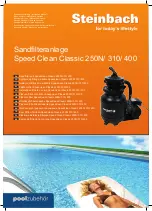
- 7 -
6.
Clean and remove electrode from the unit and store in an airtight plastic bag or jar.
7.
Store your Solar water purifier indoors. Avoid freezing.
If the pool was shut down with an insufficient ion level, or severe conditions were encountered late in the off season, less than clear water
conditions may be experienced. Upon opening:
1.
Top off water level, backwash, and vacuum as necessary.
2.
Add chlorine to clear any cloudiness, if present.
3.
Test ion level. Float unit to reestablish 0.5.
4.
If ion level is below 0.5, temporarily increase chlorine for protection.
5.
Maintain enough oxidizer to ensure water clarity.
6.
Verify pH is within 1.5-1.7 range. Correct if necessary.
OPERATIONAL CHECK
It is highly unlikely that your Solar water purifier will not generate ions. Should there be any doubt, the following quick check will visually
prove electrical generation:
1.
Fill a clear glass or plastic quart-sized jar or equivalent with pool or tap water.
2.
Clean electrodes and leave screen off.
3.
Place the Solar water purifier on the top of the jar, resting on the lip, with the electrodes immersed in the water.
4.
With a full sun shining on the solar panel, very fine bubbles will be observed after a few seconds originating from the spring coils. This
demonstrates that electrical current is being generated. Absence of bubbles indicates a problem.
HELPFUL HINTS
1.
Used cleaning acid may be poured back into pool.
2.
Allow new plaster type finishes to cure for a month prior to using the Solar water purifier.
3.
Baking soda works well to raise pH and is readily available and reasonably priced.
4.
Household bleach works excellently for small and medium sized pools. For large pools, too many gallons may be required, making more
concentrated forms of chlorine more convenient.
5.
Keep a tablet of chlorine in the skimmer or floating dispenser to provide a constant input of oxidizer into the pool. When necessary, add an
additional boost of liquid or granulated chlorine to maintain clear water.
6.
A toothbrush helps in electrode and screen cleaning.
7.
A cutoff golf tee can be used to secure the screen if the thumbscrew is lost.
8.
Store chlorine in a cool and dark place.
9.
Keep ion test kit in refrigerator.
10.
Check water hardness, measured as total dissolved solids (TDS) at your local pool store. Readings of approximately 2000 ppm or greater
indicate the need to drain and refill with fresh water. If that is not possible, partial draining and refilling is beneficial. With a high TDS, the
water cannot absorb and retain minerals very easily.
11.
The addition of cyanuric acid (stabilizer) is not necessary if you already use a stabilized form of chlorine, such as tablets.
12.
The Solar water purifier
works well with a pool cover. You may open the cover enough to float the unit; or cut a 3-inch “X” into the cover,
which allows the electrodes to remain in the water while the top is exposed to the sun.
13.
Clear, high quality water without algae and an abnormally low ion reading does not necessarily indicate that your Solar water purifier is not
Содержание Solar Pool Ionizer and Purifier
Страница 1: ...1 Solar Pool Ionizer and Purifier...
Страница 9: ...9...



























